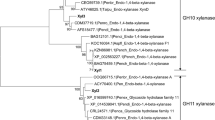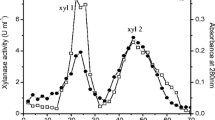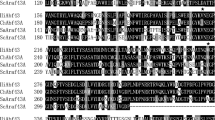Abstract
Eugenitin, a chromone derivative and a metabolite of the endophyte Mycoleptodiscus indicus, at 5 mM activated a recombinant GH11 endo-xylanase by 40 %. The in silico prediction of ligand-binding sites on the three-dimensional structure of the endo-xylanase revealed that eugenitin interacts mainly by a hydrogen bond with a serine residue and a stacking interaction of the heterocyclic aromatic ring system with a tryptophan residue. Eugenitin improved the GH11 endo-xylanase activity on different substrates, modified the optimal pH and temperature activities and slightly affected the kinetic parameters of the enzyme.




Similar content being viewed by others
References
Andrioli W, Silva TM, Silva VB, Damásio ARL, Maller A, Conti R, Jorge JA, Araújo JM, Silva CHTP, Pupo MT, Polizeli MLTM, Bastos JK (2012) The fungal metabolite eugenitin as additive for Aspergillus niveus glucoamylase activation. J Mol Catal B-Enzym 74:156–161
Biely P, Vrsanska M, Tenkanen M, Kluepfel D (1997) Endo-beta-1,4-xylanase families: differences in catalytic properties. J Biotechnol 57:151–166
Burgoyne NJ, Jackson RM (2006) Predicting protein interaction sites: binding hot-spots in protein–protein and protein-ligand interfaces. Bioinformatics 22:1335–1342
Cantarel BL, Coutinho PM, Rancurel C, Bernard T, Lombard V, Henrissat B (2009) The carbohydrate-active enzymes database (CAZy): an expert resource for glycogenomics. Nucleic Acids Res 37:233–238
Collins T, Gerday C, Feller G (2005) Xylanases, xylanase families and extremophilic xylanases. FEMS Microbiol Rev 29:3–23
Damásio ARL, Silva TM, Almeida FBR, Squina FM, Ribeiro DA, Leme AFP, Segato F, Prade RA, Jorge JA, Terenzi HF, Polizeli MLTM (2011) Heterologous expression of an Aspergillus niveus xylanase GH11 in Aspergillus nidulans and its characterization and application. Proc Biochem 46:1236–1242
Laurie AT, Jackson RM (2005) Q-SiteFinder: an energy-based method for the prediction of protein-ligand binding sites. Bioinformatics 21:1908–1916
Levasseur A, Asther M, Record E (2005) Overproduction and characterization of xylanase B of Aspergillus niger. Can J Microbiol 51:177–183
Mantyla A, Paloheimo M, Hakola S, Lindberg E, Leskinen S, Kallio J, Vehmaanpera J, Lantoo R, Suominen P (2007) Production in Trichoderma reesei of three xylanases from Chaetomium thermophile: a recombinant thermoxylanase for bleaching of kraft pulp. Appl Microbiol Biotechnol 76:377–386
Miller GL (1959) Use of dinitrosalicylic acid reagent for determination of reducing sugar. Anal Chem 31:426–428
Pollet A, Delcour JA, Courtin CM (2010) Structural determinants of the substrate specificities of xylanases from different glycoside hydrolase families. Crit Rev Biotechnol 30:176–191
Sehmid H (1949) Über die Inhaltstoffe von Eugenia caryphyllata (L.) Thunbg III. Isolierung und Konstitution des Eugenitins. Helv Chim Acta 32:813–820
Schulz B, Boyle C (2005) The endophytic continuum. Mycol Res 109:661–686
Schulz B, Boyle C, Draeger S, Aust HJ, Römmert AK, Krohn K (2002) Endophytic fungi: a source of biologically active secondary metabolites. Mycol Res 106:996–1004
Strobel G, Daisy B, Castillo U, Harper J (2004) Natural products from endophytic microorganisms. J Nat Prod 67:257–268
Sugahara M, Kageyama-Morikawa Y, Kunishima N (2011) Packing space expansion of protein crystallization screening with synthetic zeolite as a heteroepitaxic nucleant. Cryst Growth Des 11:110–120
Tsui W, Brown GD (1996) Chromones and chromanones from Baeckea frutescens. Phytochemistry 43:871–876
Verdonk ML, Cole JC, Hartshorn MJ, Murray CW, Taylor RD (2003) Improved protein-ligand docking using GOLD. Proteins 52:609–623
Acknowledgments
We are thankful to Dr. Janete M. Araújo from the Federal University of Pernambuco and to Dr. João Atílio Jorge from the University of São Paulo. This work was supported by Fundação de Amparo a Pesquisa do Estado de São Paulo (FAPESP) and Conselho Nacional de Desenvolvimento Científico e Tecnológico (CNPq).
Author information
Authors and Affiliations
Corresponding author
Additional information
Willian J. Andrioli and André R. L. Damásio both contributed equally to this work.
Rights and permissions
About this article
Cite this article
Andrioli, W.J., Damásio, A.R.L., Silva, T.M. et al. Endo-xylanase GH11 activation by the fungal metabolite eugenitin. Biotechnol Lett 34, 1487–1492 (2012). https://doi.org/10.1007/s10529-012-0918-3
Received:
Accepted:
Published:
Issue Date:
DOI: https://doi.org/10.1007/s10529-012-0918-3




